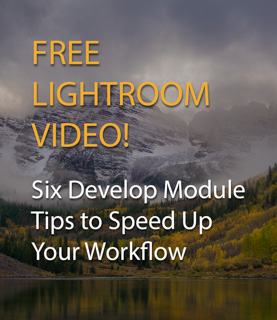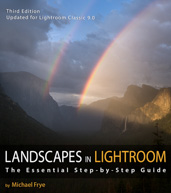In the Moment:
Michael Frye's Landscape Photography Blog
by Michael Frye | Jun 11, 2012 | Light and Weather
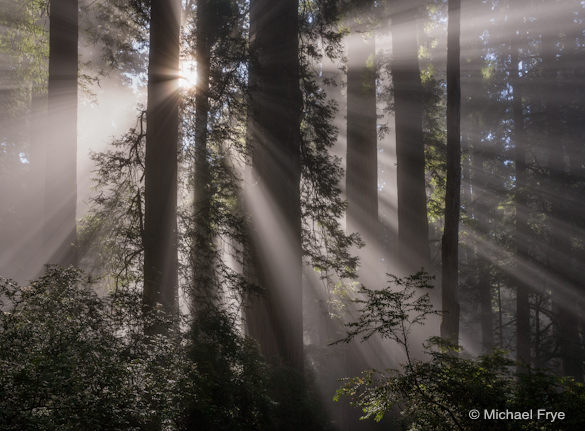
Sunbeams in the redwood forest
Last year I spent a magical day among foggy redwoods and rhododendrons along the northern California coast, and captured some of my favorite redwood photographs to date. You can see some of those photos here and here.
Claudia and I recently returned from another trip to the redwoods. On our first morning we went to the same area we visited last year, but the fog wasn’t as extensive, and not as many rhododendrons were blooming. We kept hiking, and finally reached some mist, and then something magical happened: the fog began to lift, and sunbeams started filtering through the trees. I captured the “Close Encounters” photograph below, then huffed up a steep trail to the top of a ridge and made the image at the top of this post, with classic godbeams radiating through the trees, then hurried back down, chasing the receding edge of the fog, where I found the scene in the second photograph below.
(more…)
by Michael Frye | May 30, 2012 | Advanced Techniques, Travels and Stories
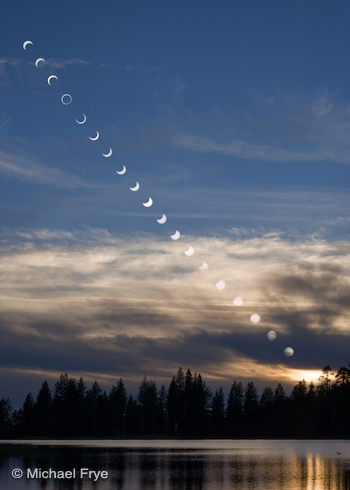
Annular eclipse sequence, Manzanita Lake, Lassen Volcanic NP, CA
Right after the annular solar eclipse on May 20th I went to the Google+ Photographers Conference in San Francisco. This was a really fun event—more about that later. But I mention this because I got involved in the conference, and then had a computer problem, and didn’t have a chance to look at my eclipse photos, much less process them, until now. So here, finally, is a photograph showing an eclipse sequence.
I felt completely unprepared for this eclipse. I’ve never photographed a solar eclipse before, so I didn’t know what to expect. I didn’t have a solar filter, and I wasn’t sure whether I could even photograph the eclipse without one. I’d read some dire warnings that photographing the eclipse without a solar filter could ruin your camera’s sensor, but this didn’t make sense to me. I’ve included the sun in hundreds of photographs and never had a problem. Exposures are short, and when the shutter is closed the light bounces off the camera’s mirror, up through the prism, and out through the back of the viewfinder. Staring through the viewfinder at the sun is not a good idea, just as it’s not a good idea to stare directly at the sun. But we have a natural defense mechanism for this known as pain: it hurts to look at the sun.
(more…)
by Michael Frye | May 17, 2012 | Yosemite Photo Conditions
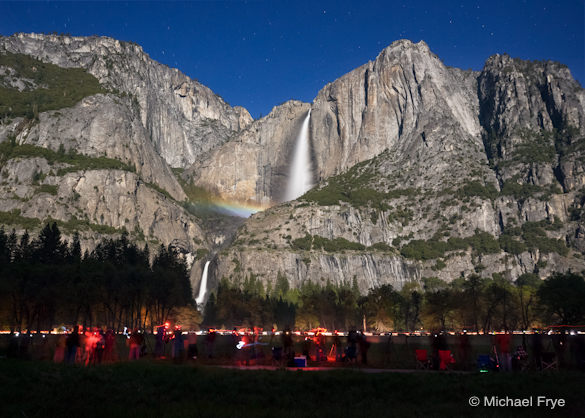
Photographers under the lunar rainbow in Cook's Meadow, May 5th
I hope that saying, “Better late than never” is true—at least this time! I’ve been really busy the since the full moon, but here, finally, are some photos of the lunar rainbow from May 4th and 5th.
Large numbers of photographers headed to Yosemite Valley that weekend to photograph dogwoods and the lunar rainbow. At times I joined four or five photographers pointing lenses at the same dogwood, and there were at least 200 people in Cook’s Meadow on Saturday evening (May 5th) watching and photographing the lunar rainbow. The photo at the top of this posts shows the moonbow and some of those attempting to photograph it.
The previous night my friend Jon McCormack and I grunted up the Yosemite Falls trail to a spot with a profile view of the upper fall. I’d photographed a lunar rainbow from this spot in 1996, but back then I didn’t have a wide enough lens on my Mamiya 645 to include Half Dome and the whole waterfall, so I thought it was time to try it again.
(more…)
by Michael Frye | May 1, 2012 | Yosemite Photo Conditions
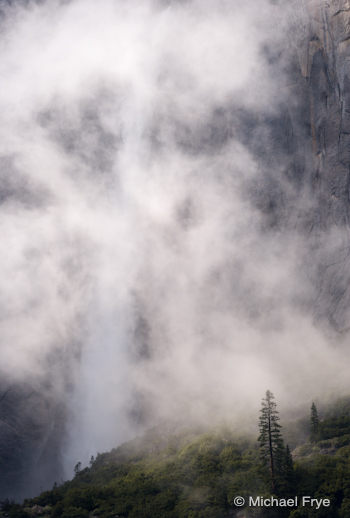
Upper Yosemite Fall through the mist, last Thursday afternoon
The moon will be full this weekend—on May 5th, at 8:36 p.m. to be precise. So that means I’ve been getting lots of questions about photographing lunar rainbows. First, the best way to find out where and when to photograph Yosemite’s lunar rainbows is astronomer Don Olson’s web site. Don and his team have figured out precise viewing times for lunar rainbows from the Lower Yosemite Fall bridge, and from Cook’s Meadow for Upper Yosemite Fall.
Temperatures are forecast to be relatively cool this weekend, which means that snow won’t be melting at a high rate, and water flow and spray will probably be below average for early May. The moonbow should be visible on the upper fall from Cook’s Meadow, but it won’t spread as wide as it did last year, nor will it be visible as long. For the lower fall, less spray is good (up to a point), because it’s easier to keep water drops off the lens from this often-damp location. I’m sure there will still be spray at the bridge below the lower fall, but it might be manageable. Whether you go to Cook’s Meadow or the Lower Yosemite Fall bridge you’ll have to share the spot with many other photographers—but there’s less room at the bridge.
(more…)
by Michael Frye | Apr 26, 2012 | Yosemite Photo Conditions
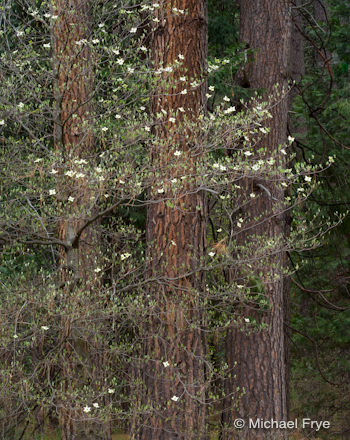
Dogwood and ponderosa pines near the Ahwahnee Hotel, yesterday morning
I’m teaching my Spring Yosemite Digital Camera workshop this week, but wanted to post a quick note to let you know that the dogwoods have suddenly popped out in Yosemite Valley. On Saturday I saw only a few green discs, but yesterday dozens of trees were in full bloom, and it seems like more are emerging every hour. The dogwoods are most photogenic when they first blossom, before too many leaves obscure the flowers, so the next week or so should be the best for photography, though the dogwoods will continue to bloom for a couple of weeks beyond that.
—Michael Frye
Michael Frye is a professional photographer specializing in landscapes and nature. He is the author and photographer of The Photographer’s Guide to Yosemite, Yosemite Meditations, and Digital Landscape Photography: In the Footsteps of Ansel Adams and the Great Masters, plus the eBooks Light & Land: Landscapes in the Digital Darkroom, and Exposure for Outdoor Photography. He has written numerous magazine articles on the art and technique of photography, and his images have been published in over thirty countries around the world. Michael has lived either in or near Yosemite National Park since 1983, currently residing just outside the park in Mariposa, California.
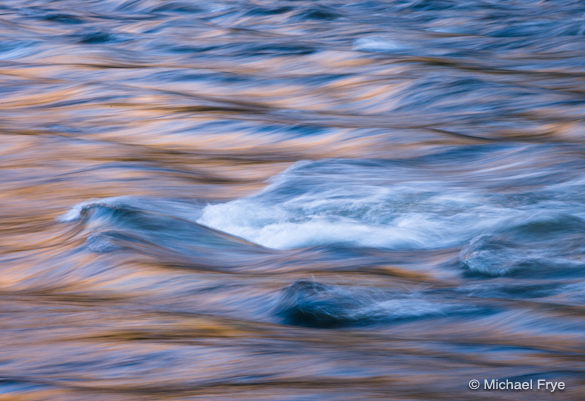
Reflections in the Merced River, Tuesday evening
by Michael Frye | Apr 20, 2012 | Uncategorized
(If you’re getting this post through email, click here to view the video.)
Here it is, my second video about the new process in Lightroom 4. In Part One I explained how the new tone controls work; here in Part Two I talk about how to use these new tools to process both low- and high-contrast images. Here are some of the main points:
– Where to begin? If you’ve read my eBook Light and Land, or watched one of my previous videos about curves, you know that in the old process I preferred starting with all the Basic tone controls set at zero, and the point curve linear. Does this still apply in the new process? (1:10)
– Curves or sliders? The new Basic Tone sliders are much better than the old ones; are they good enough to replace the Point Curve? (10:30)
– Does the order matter? Adobe suggests using the Basic tools in order from top to bottom, starting with Exposure, then Contrast, and working down to Highlights, Shadows, Whites, and Blacks—essentially working from the midtones out to the black point and white point. But this contradicts a long-standing tradition in digital imaging of setting the black point and white point first. Should you stand with tradition, or embrace the new order? (13:02)
– Processing a high-contrast image. (21:04)
This video is about 27 minutes long, so, as I said with Part 1, grab your favorite beverage, sit back, relax, and enjoy the show. Spending a little time with this video now will save time later when you’re processing photos. More importantly, I hope that this video will help you get the most out of your images so that they convey what you saw and felt when you pressed the shutter.
As I mention in the video, the best way to learn more about processing images in Lightroom is to take a workshop. There’s are still a couple of spots available in my October workshop, The Digital Landscape: Autumn in Yosemite. This is a comprehensive course covering the entire process from capture to print, with field sessions covering exposure, composition, and everything you do before pressing the shutter, and lab sessions where we process and print the images with Lightroom.
I hope you enjoy Part 2!
—Michael Frye
Related Posts: Lightroom 4: The New Tone Controls; Using Curves in Lightroom and Camera Raw
Michael Frye is a professional photographer specializing in landscapes and nature. He is the author and photographer of The Photographer’s Guide to Yosemite, Yosemite Meditations, and Digital Landscape Photography: In the Footsteps of Ansel Adams and the Great Masters, plus the eBooks Light & Land: Landscapes in the Digital Darkroom, and Exposure for Outdoor Photography. He has written numerous magazine articles on the art and technique of photography, and his images have been published in over thirty countries around the world. Michael has lived either in or near Yosemite National Park since 1983, currently residing just outside the park in Mariposa, California.
by Michael Frye | Apr 15, 2012 | Announcements

Unfiltered Object #4 by Jeff Grandy
Planning to visit Yosemite in the next few weeks for the waterfalls and dogwood bloom? While you’re there, stop by The Ansel Adams Gallery and see the current exhibit by Jeff Grandy, featuring prints from his exquisite Unfiltered Series. The show will be on display until May 10th.
Jeff is a long-time friend, and I’ve always loved his classic landscape images, but this new work of his is quite different. He’s focused on the colors and textures of water, and created a series of abstract and imaginative images. You can see some samples on Jeff’s website.
There will be reception for the artist April 21st from 3:00-5:00 and I plan to attend. Hope to see you there!
— Michael Frye
Michael Frye is a professional photographer specializing in landscapes and nature. He is the author and photographer of The Photographer’s Guide to Yosemite, Yosemite Meditations, and Digital Landscape Photography: In the Footsteps of Ansel Adams and the Great Masters, plus the eBooks Light & Land: Landscapes in the Digital Darkroom, and Exposure for Outdoor Photography. He has written numerous magazine articles on the art and technique of photography, and his images have been published in over thirty countries around the world. Michael has lived either in or near Yosemite National Park since 1983, currently residing just outside the park in Mariposa, California.
by Michael Frye | Apr 13, 2012 | Uncategorized
(If you’re getting this post through email, click here to view the video.)
As I wrote last week, Lightroom 4 represents a big change—the biggest change to Adobe’s Raw processing engine since Adobe Camera Raw was introduced in 2003. They’ve completely revamped the underlying algorithms for all of the tonal controls, and changed the behavior, and in some cases the names, of all the Basic Tone sliders.
Overall, I’m really happy with the new process, especially for high-contrast images. But if you’re accustomed to Lightroom 3 the new tools may seem strange at first. So I’ve been working on two videos to explain the changes and how to work with the new tools.
The first video, embedded here, explains some of the differences between the old and new processes, how the new tools work, and the ways they affect an image’s appearance. Here are some of the main points:
(more…)
by Michael Frye | Apr 10, 2012 | Yosemite Photo Conditions
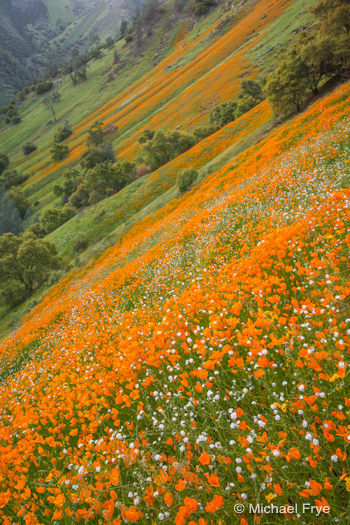
Poppies in the Merced River Canyon, Sunday afternoon
It’s turning out to be a great year for poppies in the Merced River Canyon, along Highway 140 just west of Yosemite. While nothing may ever match the spectacular poppy bloom of 2009, this season is coming pretty close. There’s a brilliant display on the north side of the canyon about three miles east of Briceburg, with poppies reaching from the river to the ridge tops. A mile or two further east, around Grandy’s Hill, you can find some great patches of flowers above the road on the south side of the canyon. And there are plenty of poppies at the beginning of the Hite’s Cove trail.
The bloom seems to be spreading from west to east, as it did in 2009. During the last week poppies have appeared in many places on the north side of the canyon from the rock-slide to El Portal, including some of the areas burned in last year’s Motor Fire. I’m hoping that this spread will continue, and we’ll see poppies blooming for two or three more weeks.
Despite the fact that this is mostly unfenced public land, and some of the best poppy displays are on the same side of the river as the highway, access to the flowers is difficult. The hillsides are extremely steep. Not fall-off-and-you’ll die steep (at least in most places), but it requires a lot of agility, stamina, and sure-footedness to climb up many of these hills, and a slip could cause injury. Most people are going to be limited to telephoto views from the road. The one spot with relatively easy access to close-up views of poppies is the beginning of the Hite’s Cove trail.
(more…)
by Michael Frye | Apr 6, 2012 | Digital Darkroom
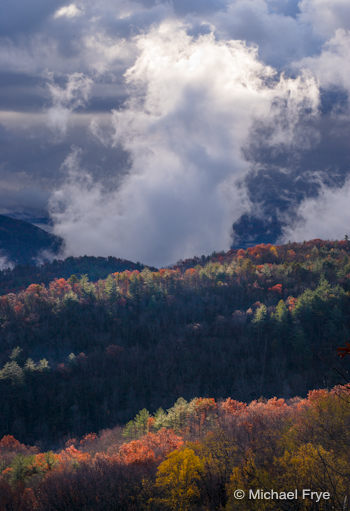
Clearing storm along the North Carolina-South Carolina border—processed with Lightroom 4
I’ve finally had a chance to really dive into Lightroom 4, and I’m very happy with the results I’ve been getting. While I haven’t found a big difference in processing low-contrast images, with high-contrast scenes the improvements are significant.
The accompanying image was made during my trip to South Carolina last November. It was a fast-changing situation—the sun suddenly broke through, and I missed the exposure slightly, so the brightest highlights at the top of the clouds were blown out. By the time I adjusted the exposure the scene had changed.
(more…)










